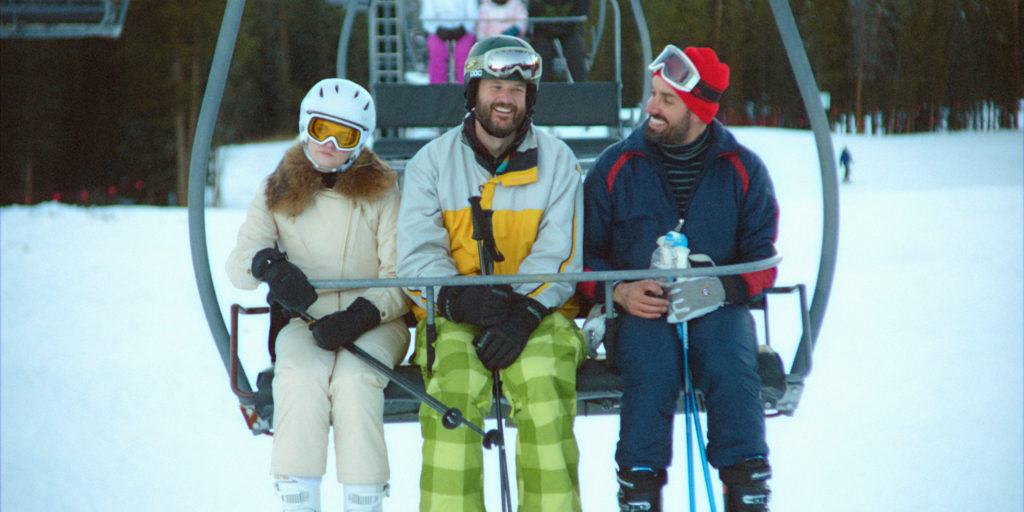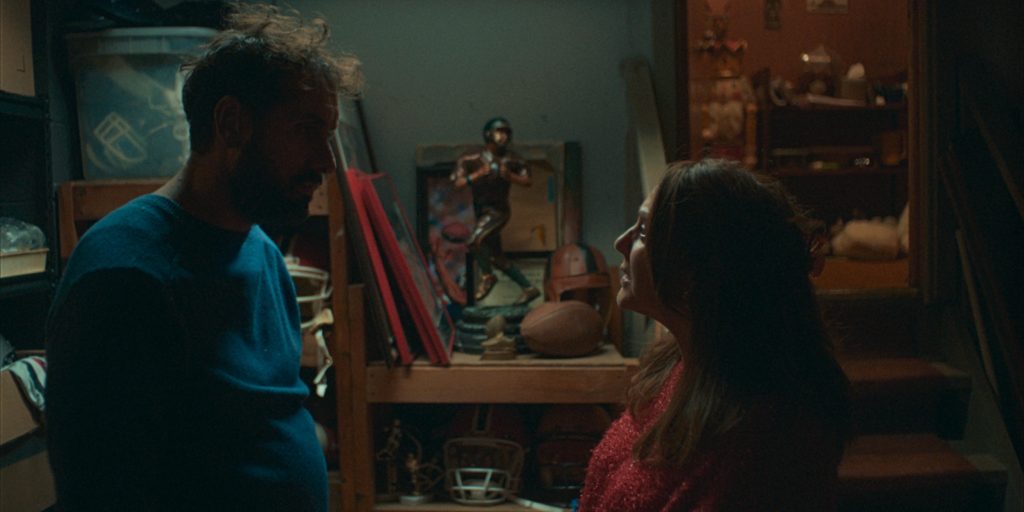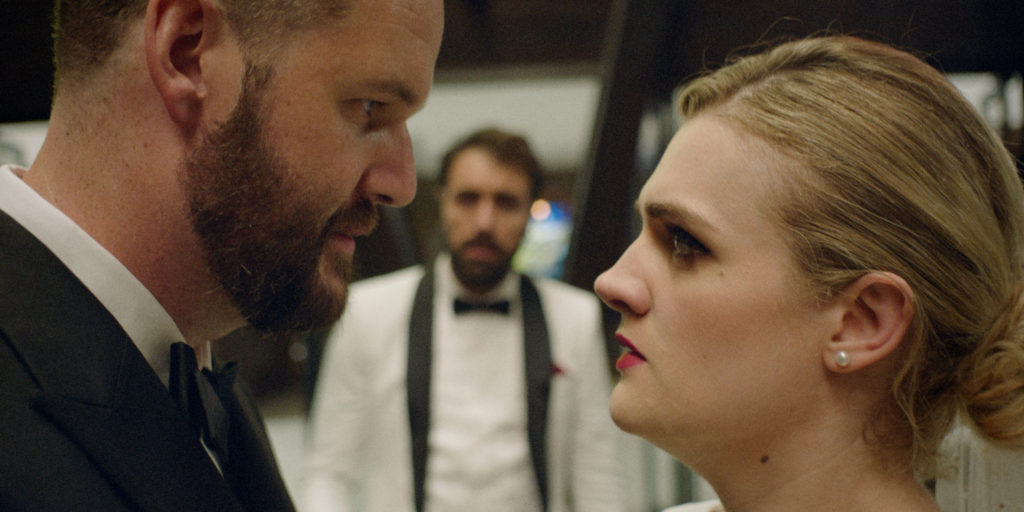The buddy comedy is a venerable movie genre, but there have been few movie buddies like Mike and Kyle, the duo at the center of the acclaimed Sony Pictures Classics release The Climb. In the opening scene, as the best friends are cycling in the South of France and schlubby Kyle rhapsodizes about his pending marriage, Mike blurts out that he’s slept with Kyle’s fiancée. That’s just the first bump in a decade-spanning relationship that’s equally sustaining and toxic.
Mike and Kyle are actually played by two best friends, director Michael Angelo Covino and his co-writer, Kyle Marvin, in comically heightened versions of their own disparate personalities. (In a nutshell, Kyle is the gentle pushover, and Mike is the aggressive one.) What also distinguishes The Climb is its style: That bike ride, the confession, and its madcap aftermath are all filmed in one lengthy, precisely choreographed single take. And all the sequences that follow, which often jump far ahead in time, are also conceived as elaborate single takes. The ambitiousness of this low-budget indie, expanded from a short the pair debuted at Sundance in 2018, earned it the Un Certain Regard Jury Coup de Coeur at last spring’s Cannes Film Festival and the Jury Prize at the Deauville Film Festival.
The original short comprised the opening bike ride. “What we realized as we were rehearsing that and eventually shooting is that those characters were interesting for us to explore in a longer story,” Covino recalls. “One character is very giving almost to a fault and the other character is selfish to a fault, but they just had this bond that they couldn’t get rid of. How would that story play out over a lifetime? That was the thing that Kyle and I both responded so strongly to, that made us want to stop everything we were doing and go figure out how to turn it into a feature.”
“In the early conversations on the script,” Marvin notes, “we talked about doing something like Rope, where you never cut and you just live in this space. But we ended up pursuing this version where we travel over longer periods of time and utilize a similar sort of camerawork, but to consciously add interruptions in between to give you a break or a palette cleanse before we throw you halfway in the middle of a scene and make the audience catch up and get immersed again.”
Asked about his decision to use long takes, Covino half-jokingly responds. “The simple answer is that I hate editing, so it just made the whole process easier. But not really. It adds way more complexity to shoot it in one take, but it also simplifies the edit in some ways. But the real decision came from the fact that there was this immediacy in shooting the short that way. We found ourselves not wanting to look away and just experiencing real time and watching these characters struggle through this uphill battle while also struggling through their conversation. The pacing of the conversation organically just felt different than it probably would have if we were cutting it up and covering it in a more traditional sense. That was really exciting.”

An essential partner in making this concept work was cinematographer Zach Kuperstein (The Eyes of My Mother). “We developed a really beautiful relationship throughout the process of making this movie,” Covino says. “Sometimes he was operating when it was handheld, and other times it was our Steadicam operator and he and I just creating this sort of dance. We considered the perspective of the camera almost a character within the scene sometimes. It had to move differently depending on what feelings were we trying to convey. In that scene where the camera wraps around the house [during a Thanksgiving gathering] and my character is seeing this family for the first time after betraying them all, we got this idea of removing the camera and placing it outside and letting it have an outsider perspective as we’re watching this person go through this series of hurdles. There was a constant conversation with Zach about how the camera contributed to the story, communicating additional layers of emotion.”
Audiences might be forgiven for thinking Covino and Marvin are playing themselves. So how close are they to their onscreen characters? “We’re getting closer and closer tthe longer this goes on. I think we projected our future,” Marvin jokes. “We inherently have traits which naturally fed into the characters. In the short, and then for the feature, we just leaned into them to make them more interesting. Mike hasn’t slept with my wife, as far as I know. He’s not normally that kind of a personality, but there’s pieces of the pushover nature that’s inherent in me and a piece of the aggressive nature that’s in Mike. It was fun for us to expand it out… Part of the reason why we used our real names was to blur that line a little and have this conversation. We thought it would be interesting.”

Covino and Marvin met 10 years ago working on a commercial, and soon formed their own commercial production company. “We’d work together in various capacities, but never as writing partners,” Covino recalls. “And then one day, like four or five years ago, we were just like, why don’t we try writing a pilot together? And we did that and it actually felt very seamless. What we turned out ended up being great and we sold that pilot and it was like, oh wow, there might be something here.”
The duo’s comic heroes include Monty Python and Jim Carrey. “There’s something about slapstick,” Covino says. “When I was little, I dressed up like Charlie Chaplin almost every Halloween for some reason. My parents and my grandparents would lead me into watching old comedy classics, which is probably part of why we gravitate toward having these deeper emotional moments in the movie that are interrupted by physical comedy.”
Marvin adds, “There’s something in our sensibility about pacing that some of the greats like Jim Carrey have. They have an authenticity to their characters, but they also have a command over timing and pacing. And that I think is a mark of good comedy. We were given the luxury of being able to say, hey, we’re going to set up a joke and then pay it off six minutes later. And luckily our financiers stood by it. It’s something that takes a little bit of committing to both as a performer and as an audience member, to just say we’re really gonna commit to this thing and it might take more time than we’re used to. Unlike the new style of American comedy, where it’s pack as many jokes into this scene as you can, as fast as possible.”
“That’s the best thing about doing these long takes in a comedy,” Covino says. “It handcuffed us to not be pressured into cutting in more jokes. By pacing the movie slower, it allowed us to be a bit more patient with our comedy, and therefore certain jokes land harder because they weren’t preceded by three jokes where we were just trying to keep the pace of the scene entertaining. We have the luxury of what a lot of the great comedic filmmakers in the past had, people like Mel Brooks and Mike Nichols—filmmakers who created film at a time when there was just an inherent level of patience that was greater than what exists today, when people would go to a theater and watch The Deer Hunter and a 20-minute wedding scene and be okay with it. That stuff doesn’t really fly as much in cinema any more, certainly not in comedy. And that at times can be to a fault, because half of what makes something funny is the anticipation of it.”
As huge fans of French cinema, Covino and Marvin say they were “walking on a cloud” when The Climb debuted in Cannes. “We shot the opening scene 30 minutes from Cannes, not really thinking that would be any reason why anyone would accept it there,” Covino says. “But we thought, let’s start it there and maybe we’ll end it there in some way. That was a conversation between Kyle and I: How do we make this comedy, and how do we make it in a way that maybe if we knock it out of the park or pull a rabbit out of a hat, we could go to Cannes with it? Because that is the pinnacle of world cinema. That’s the spot where you immerse yourself in French cinema and try to inspire yourself to write your American love letter to French cinema.”

Sony Pictures Classics acquired the film during Cannes’ closing weekend. “They have a love and appreciation for film,” Marvin says. “For us they were a good fit in that they give theatrical support to films which sometimes need a little bit of time to find their legs. It’s a great partnership with someone who’s willing to put us in theaters and keep us on screens while people discover the film. Because Mike and I are not household names and it’s a tricky time to go into theaters with comedies, but they check the exact box that we were looking for. Someone who’d be willing to support a film in theaters.” SPC opens the film on July 17.
Covino and Marvin have already written a TV show and are working on a new feature script. Will it be similar to The Climb? “I think everything we do will be character-driven, because that’s our way into writing,” Covino says. “There’s a bittersweet quality that our movie has a bit of that we love exploring. Finding humor in sadness and in darker kinds of experiences is something that we gravitate toward. That’s my approach as a director more than anything. I love a slower-paced approach to filmmaking, but I don’t think I would ever make another movie that is long single takes for each scene. But certainly elements of that aesthetic we would incorporate into any movie or show that we would do.”
Covino recently completed filming a small role as a villain in News of the World, Paul Greengrass’s post-Civil War western starring Tom Hanks. Both he and Marvin say they’re looking to branch out as actors. “That’s the thrill and the joy of creating art,” Marvin says, “to try and do something different.”
“On that note,” Covino jokes, “we are going to make The Climb 2.”
The post Uphill Battlers: Michael Angelo Covino and Kyle Marvin Play Comic Alter Egos in <em>The Climb</em> appeared first on Boxoffice.
from Boxoffice





0 comments:
Post a Comment